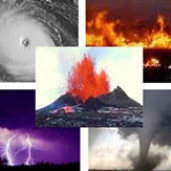
A volcano is a mountain that opens downward to a reservoir of molten rock (like a huge pool of melted rocks) below the earth’s surface.
Unlike mountains, which are pushed up from the earth’s crust, volcanoes are formed by their buildup of lava, ash flows, and airborne ash and dust.
When pressure from gases and molten rock becomes strong enough to cause an explosion, it erupts and starts to spew gases and rocks through the opening.
Volcanic eruptions can hurl hot rocks (sometimes called tephra) for at least 20 miles (32 km) and cause sideways blasts, lava flows, hot ash flows, avalanches, landslides and mudflows (also called lahars).
They can also cause earthquakes, thunderstorms, flash floods, wildfires, and tsunamis. Sometimes volcanic eruptions can drive people from their homes forever.
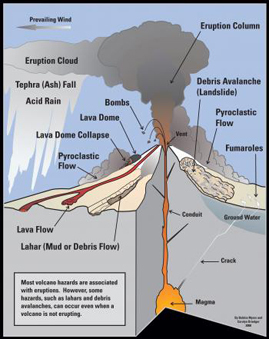
Fresh volcanic ash is not like soft ash in a fireplace. Volcanic ash is made of crushed or powdery rocks, crystals from different types of minerals, and glass fragments that are extremely small like dust. But it is hard, gritty, smelly, sometimes corrosive or acidic (means it can wear away or burn things) and does not dissolve in water.
The ash is hot near the volcano but is cool when it falls over great distances. Ashfall is very irritating to skin and eyes and the combination of ash and burning gas can cause lung irritation or damage to small infants, the elderly or people with breathing problems.
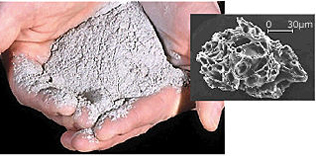
Did you know…
- there are about 1 million volcanoes on the ocean’s floor which pump out roughly 3/4 of the lava reaching the earth’s surface;
- the Ring of Fire that encircles the Pacific Ocean has about 450 of the approximate 1,300 historically active volcanoes according to the Smithsonian Institute’s Global Volcanism Program;
- the U.S. has over 65 active or potentially active volcanoes and over 40 of them are in Alaska;
- volcanic eruptions can impact our global climate since they release ash and gases (like sulfur and carbon dioxide) into the earth’s atmosphere and warm the oceans;
- floods, airborne ash or dangerous fumes can spread 100 miles (160 km) or more;
- Yellowstone National Park actually sits on top of a supervolcano which erupted 3 times in the past 2 million years forming 3 massive calderas (or huge craters)? Some other supervolcanoes are in Alaska, California, New Mexico, Indonesia, Japan, New Zealand and South America.
BEFORE A VOLCANIC ERUPTION:
Prepare – Try to cover and protect machinery, electronic devices, downspouts, etc. from ashfall. Learn more by visiting the USGS Volcano Hazards Program site at https://volcanoes.usgs.gov/volcanic_ash/
Learn alert levels – Ask emergency management office which volcano warnings or alert levels are used since they vary depending on where you live (can be alert levels, status levels, condition levels or color codes).
Make a plan – Develop a Family Emergency Plan and Disaster Supplies Kit. (Note: Put in goggles or safety glasses and dust masks for each family member to protect eyes and lungs from ash.) Download a free 68-pg PDF portion of USFRA's custom Family Preparedness Guide that includes tips on making a plan and kit and more.
Okay to go? – Don’t go to active volcano sites unless officials say it’s okay.
Be ready to evacuate – Listen to local authorities and leave if you are told to evacuate.
DURING A VOLCANIC ERUPTION:
Listen – Do what local authorities say, especially if they tell you to leave!
Leave – If you are told to evacuate, DO IT! Don’t think you are safe to stay home … the blast can go for miles/kilometres and cause wildfires and other hazards!
Watch out – Eruptions cause many other disasters:
- flying rocks – hurled for miles at extremely fast speeds
- mudflows, landslides or lahars – they move faster than you can walk or run
- fires – hot rocks and hot lava will cause buildings and forests to burn
- lava flows – burning liquid rock and nothing can stop it
- gases and ash – try to stay upwind since winds will carry these — they are very harmful to your lungs
- vog – volcanic smog forms when sulfur dioxide and other pollutants react with oxygen, moisture and sunlight – can cause headaches, breathing difficulties and lung damage
IF INDOORS – Stay in, but be aware of ash, rocks, mudflows or lava!
- Close all windows, doors, vents and dampers and turn off A/C and fans to keep ash fall out.
- Put damp towels under doorways and drafty windows.
- Bring pets inside (if time, move livestock into shelters).
- Listen for creaking on your rooftop (in case ashfall gets heavy — could cause roof to collapse!)
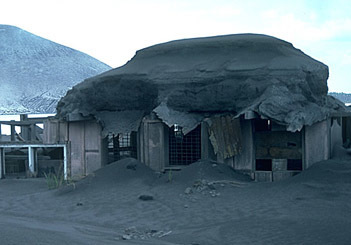
IF OUTDOORS – Try to get indoors, if not…
- Stay upwind so ash and gases are blown away from you.
- Watch for falling rocks and, if you get caught in rockfall, roll into a ball to protect your head!
- Get to higher ground – avoid low-lying areas since poisonous gases collect there and flash floods could happen.
- Use dust-mask or damp cloth to help breathing, wear long-sleeved shirts and pants, and use goggles.
- Ashfall can block out sunlight and may cause lightning.
IF IN A VEHICLE – Avoid driving unless absolutely required.
- Slow down — keep speed at 35 mph (56 km/h) or slower, mainly because of thick dust and low visibility.
- Shut off engine and park in garage (driving stirs up ash that can clog motor and damage moving engine parts).
- Look upstream before crossing a bridge in case a mudflow or landslide is coming.
AFTER A VOLCANIC ERUPTION:
Listen – Local authorities will say if and when it’s safe to return to area (especially if you had to evacuate) and give other updates when available.
Water – Check with authorities before using water, even if eruption was just ash fall (gases and ash can contaminate water reserves). Don’t wash ash into drainpipes, sewers or storm drains since wet ash can wear away metal.
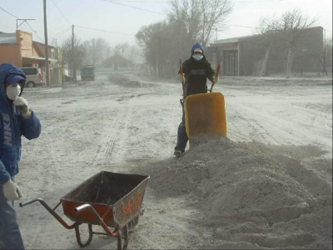
What to wear – If you must be around ash fall, you should wear long sleeve shirts, pants, sturdy boots or shoes, gloves, goggles (or safety glasses) and keep your mouth and nose covered with a dust-mask or damp cloth.
Ash – Dampen ash before sweeping or shoveling buildup so it’s easier to remove and won’t fly back up in the air as much – but be careful since wet ash is slippery. Wear protective clothing and a dust mask too. Realize ash can disrupt lives of people and critters for months.
Protect – Cover machinery and electronic devices like computers.
Above extracted from IT’S A DISASTER! …and what are YOU gonna do about it? by Bill and Janet Liebsch ~ download a free 68-pg portion of USFRA's custom ebook in PDF
Additional resources:
USGS Volcano Hazards Program http://volcanoes.usgs.gov/
Smithsonian Institute’s Global Volcanism Program www.volcano.si.edu

